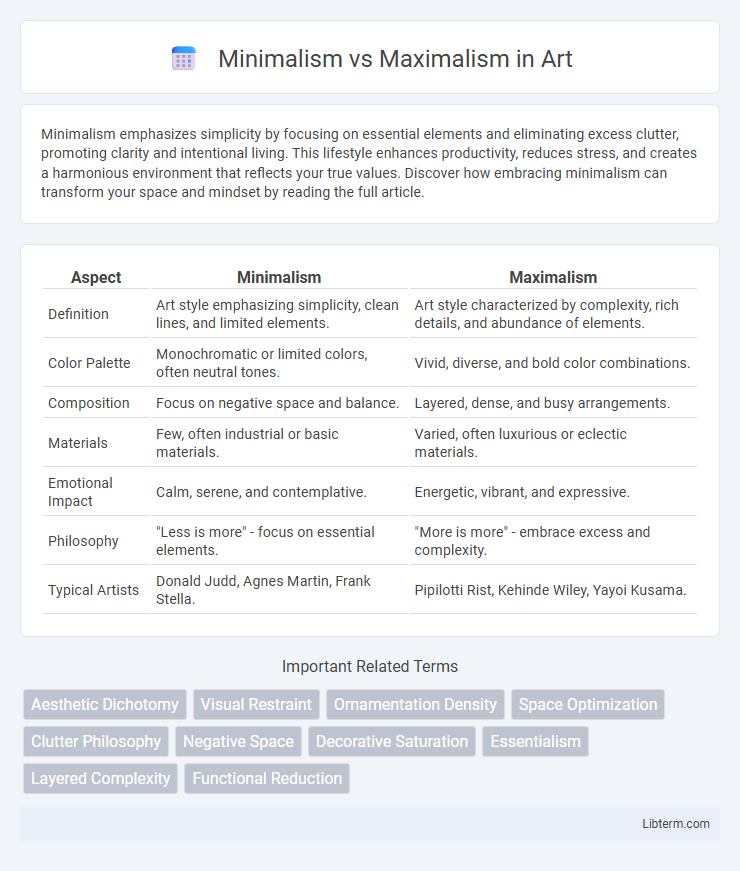Minimalism emphasizes simplicity by focusing on essential elements and eliminating excess clutter, promoting clarity and intentional living. This lifestyle enhances productivity, reduces stress, and creates a harmonious environment that reflects your true values. Discover how embracing minimalism can transform your space and mindset by reading the full article.
Table of Comparison
| Aspect | Minimalism | Maximalism |
|---|---|---|
| Definition | Art style emphasizing simplicity, clean lines, and limited elements. | Art style characterized by complexity, rich details, and abundance of elements. |
| Color Palette | Monochromatic or limited colors, often neutral tones. | Vivid, diverse, and bold color combinations. |
| Composition | Focus on negative space and balance. | Layered, dense, and busy arrangements. |
| Materials | Few, often industrial or basic materials. | Varied, often luxurious or eclectic materials. |
| Emotional Impact | Calm, serene, and contemplative. | Energetic, vibrant, and expressive. |
| Philosophy | "Less is more" - focus on essential elements. | "More is more" - embrace excess and complexity. |
| Typical Artists | Donald Judd, Agnes Martin, Frank Stella. | Pipilotti Rist, Kehinde Wiley, Yayoi Kusama. |
Understanding Minimalism: The Art of Less
Minimalism emphasizes simplicity, clean lines, and a restrained color palette to create calm and clutter-free spaces that enhance functionality and focus. This design philosophy prioritizes essential elements, eliminating excess to foster a sense of clarity and intentional living. By reducing visual noise, minimalism cultivates an environment that promotes mindfulness and efficiency.
Defining Maximalism: Celebrating Abundance
Maximalism embraces vibrant colors, bold patterns, and layered textures to create visually rich and dynamic spaces that celebrate abundance. It prioritizes eclectic decor, ornate details, and a mix of cultural influences, reflecting personality and storytelling through design. This approach encourages embracing excess and complexity, contrasting minimalism's simplicity by valuing diversity and expressive creativity.
Key Philosophies: Simplicity vs. Expression
Minimalism emphasizes simplicity, reducing elements to their essential forms to create clean, functional, and uncluttered spaces that evoke calm and clarity. Maximalism prioritizes expression by layering colors, textures, and patterns to showcase personality, creativity, and abundance, celebrating complexity and visual richness. These contrasting philosophies define the core approach to design, influencing aesthetics, emotional impact, and user experience.
Visual Differences Between Minimalism and Maximalism
Minimalism emphasizes clean lines, open spaces, and a restrained color palette, creating a sense of calm and simplicity through the use of negative space and limited decor. In contrast, maximalism embraces bold patterns, vibrant colors, and an abundance of textures, often layering various elements to produce a rich and visually stimulating environment. The stark visual difference lies in minimalism's focus on reduction and clarity, whereas maximalism prioritizes complexity and exuberance in design.
Historical Origins and Influences
Minimalism emerged in the 1960s as a reaction against the complexity of Abstract Expressionism, drawing inspiration from artists like Donald Judd and Agnes Martin who emphasized simplicity, geometric forms, and industrial materials. Maximalism, with roots tracing back to Baroque and Rococo art periods, embraces ornate details, bold colors, and eclectic patterns, influenced by historical styles such as Victorian and Art Deco design. Both movements reflect cultural responses to their eras: Minimalism promotes clarity and function during post-war modernism, while Maximalism revives excess and decorative richness as a counterpoint to austerity.
Practical Applications in Interior Design
Minimalism in interior design emphasizes clean lines, neutral color palettes, and functional furniture to create open, uncluttered spaces that promote tranquility and efficiency. Maximalism embraces bold colors, diverse patterns, and eclectic decor, encouraging personalized and layered environments rich with visual interest and cultural expression. Practical applications of minimalism suit small spaces and modern lifestyles, while maximalism benefits those seeking creativity and warmth through abundant details and dynamic aesthetics.
Minimalism vs. Maximalism in Fashion
Minimalism in fashion emphasizes simplicity, clean lines, and a muted color palette, creating timeless and versatile wardrobes that prioritize functionality and subtle elegance. Maximalism, by contrast, embraces bold patterns, vibrant colors, and eclectic layering, encouraging individual expression and visual complexity. Both styles influence contemporary fashion trends, with minimalism often favored for its sustainability and ease, while maximalism appeals to those seeking creativity and statement-making ensembles.
Psychological Impact: Calm vs. Stimulation
Minimalism promotes psychological calm by reducing visual clutter, which helps lower stress and enhances focus through simplicity. Maximalism stimulates the brain with rich colors, diverse textures, and abundant patterns, encouraging creativity and emotional energy. Both approaches impact mental states differently, with minimalism fostering tranquility and maximalism driving cognitive engagement.
Environmental Considerations and Sustainability
Minimalism emphasizes reducing consumption, waste, and resource use, promoting sustainable living through simplicity and eco-friendly materials. Maximalism, while showcasing abundance and diversity, often requires more energy, materials, and resources, potentially increasing environmental impact. Choosing minimalism can lead to lower carbon footprints and less clutter, aligning with sustainability goals.
Finding Your Style: Balancing Minimalism and Maximalism
Finding your style involves balancing minimalism's clean, functional aesthetics with maximalism's vibrant, eclectic expressions to create a personalized living space. Emphasizing key elements such as color schemes, textures, and focal points enables harmony between simplicity and abundance, enhancing both comfort and visual interest. This tailored approach ensures that the design reflects individual personality while maintaining coherence and intentionality within the environment.
Minimalism Infographic

 libterm.com
libterm.com